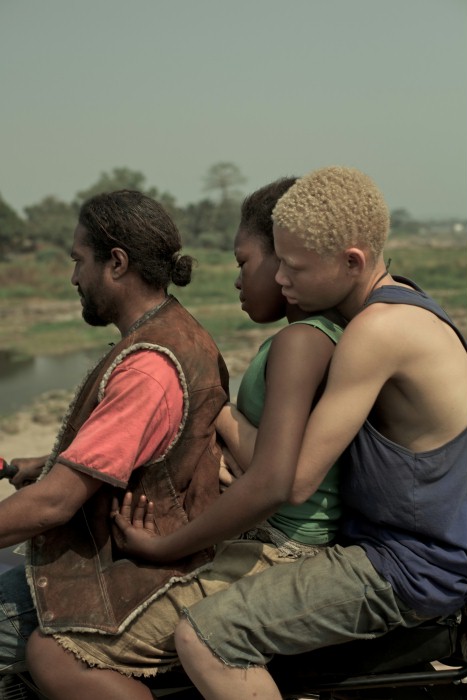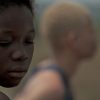A guide to movies in the 2012 Berlinale featuring people from the African diaspora.
I am thrilled at about the new black films that I’ve seen recently. Sundance was full of treasures this year like Pariah, Red Hook Summer & Middle of Nowhere which won a best director award. Viola Davis won the Best Actress Screen Actors Guild Award this year – the first time in 72 years for a black woman. And the Berlinale really came with it this year and features 15 movies that tell stories which are not heard enough.
Out of Africa is part of a Meryl Streep retrospective but it acts as a point of reference for the other films in this guide because it typifies an era when our stories were told only as plot devices played by one-dimensional background characters. The other films offer more first-hand accounts and depth.
I am looking forward to snapping my way through Leave it On The Floor and shaking my head through Call Me Kuchu . The portrayals of often-ignored LGBT people has me especially excited about these films. Our piece on Audre Lorde by Alexis Gumbs has me so curious that there is no way I would miss Audre Lorde – The Berlin Years 1984 to 1992
Every film is either in English or has English sub-titles and you can get tickets today.
Film descriptions are after the photo gallery. Enjoy!
After endless years of the Liberian civil war, 17 year old Vele is struggling to make the future brighter for her and her two daughters – learning to read and write is the first step.
Audre Lorde – The Berlin Years 1984 to 1992


It is exactly twenty years since the celebrated Afro-American poet and writer Audre Lorde died in 1992. According to her own description of herself she was: ‘a lesbian, a feminist, black, a poet, mother and activist’. In the 1980s Dagmar Schultz, who at the time was lecturing at the John F. Kennedy Institute at Berlin’s Freie Universität, invited Lorde to Berlin as a visiting professor. This move was to have an enduring influence, for Lorde soon became co-founder and mentor of the Afro-German movement. In her documentary portrait, Dagmar Schultz distils hitherto unpublished and often very personal material of Lorde that portrays her among her Berlin women friends, fellow-travellers and students, many of whom she encouraged to begin writing. These women were later to become poets and academics; they were the ones to create the first German-language works about Afro-German history and racism. The film includes appearances from, among others: May Ayim, Katharina Oguntoye, Gloria I. Joseph, Ilona Bubeck, Traude Bührmann, as well as Ika Hügel-Marshall and Ria Cheatom, both of whom collaborated on the making of this film.
Today is the last day of his life. He knows this to be true even though he is strong and healthy. Nonetheless Satché (played by American actor-musician Saül Williams) accepts his imminent death. Walking through the streets of his home town in Senegal he takes in the sites of his past as if he were looking at them for the last time: his parents’ house, his first love, the friends of his youth, his wife and children. Time and again he hears the same reproach: why didn’t he stay in America, where he would have a future? Satché encounters his final moments full of fear but also with a sense of joy.
In his film, director Alain Gomis takes a well-worn topic in Senegalese cinema and turns it on its head: unlike other films, many of which choose to focus on emigration and neo-colonialism, Gomis’ work instead tells the story of a man who leaves America to return to the land of his birth. At first Satché’s fellow-Senegalese accompany him lovingly and treat him almost as if he were a saint, but as the day continues Satché discovers how malicious and greedy they can be. Several of the romantic memories he harboured from a distance turn out to be banal when he is face to face with them; nonetheless Satché’s encounter with this reality manages to bring him peace.
The anti-homosexuality bill that religious groups in Uganda are trying to have passed, calls for imprisonment of homosexuals and, in ‘severe cases’ even the death penalty. In a country where ninety-five percent of the population condone the criminalisation of homosexuality, a group of queer activists are fighting to prevent this legislative proposal from going ahead.
This film describes the life of David Katos, Uganda’s first openly gay activist, and his comrades-in-arms. His is a life constantly pervaded by fear of attack, but also characterised by moments of happiness and celebration. The film contains the hate-filled and sarcastic tirades of Christian fanatics, but also introduces us to Bishop Christopher Senyonjo, the only cleric to position himself on the side of the persecuted gay community and offer them his protection from attacks.
Events take a tragic turn when David Kato is found dead in his bed having been bludgeoned to death. When at Kato’s funeral the parson begins to preach a hateful anti-gay sermon and causes uproar, Senyonjo once again steps in to give Kato his last rites and console the activist’s mourners.
In its quietly observational way, this film portrays an exceptionally homophobic and Christian-fanatical environment, the extremity of which helps to strengthen Uganda’s LGTB community.
Chocó is twenty-seven years old; she has two children, a tiny wooden hut on the edge of a Columbian village, an underpaid job in a gold mine and a marimba-playing husband named Everlides, who gambles away the little money they have and forces himself onto her at night when he’s had too much to drink. Nonetheless she truly believes that things will get better. But then she loses her job, her daughter wants her birthday cake and Everlides spends the last of their savings. Chocó finds herself standing in the village shop she passes every day and in front of which Everlides drinks away all their money and loses at dominoes. She looks at the colourful cakes on the counter. You won’t get anything for nothing here, the fat shopkeeper reminds her. If you want a cake, I want you.
CHOCÓ is South American producer and screenwriter Jhonny Hendrix Hinestroza’s directorial debut. In quiet, low-key shots that casually capture the landscape of Columbia, he demonstrates how sometimes there’s barely breathing room between hope and despair.
Each of these film portraits begins with a long travelling shot towards the death chamber where the condemned individual will receive their lethal injection. Meanwhile, Werner Herzog’s off-screen voice pronounces that he is an opponent of the death sentence. Herzog’s gently formulated line in questioning succeeds in eliciting responses from his interviewees that are no less sensitive yet strangely matter-of-fact and seem to surface like disclosures from the depths of the human soul.
Years after his brother’s death, Burkinese filmmaker Michel Zongo sets out on a personal reconnaissance mission to the Ivory Coast. That is where Joanny was headed long ago, never to return, travelling like so many young men to the country’s more affluent neighbour in search of work. Questions about his whereabouts plague the director: Who was Joanny anyway and how did he live and die?
Once there, Zongo meets a whole Burkinese community who labour under harsh conditions on cocoa and coffee plantations. They all hope to earn lots of money in a short period of time before returning home. Yet in most cases, the reality is different. In one of the most moving scenes, the director plays his cousin Augustin a video message from his mother, in which she reproaches him for not contacting her and complains that her house is in urgent need of repair. Her words hit Augustin hard. His face reflects the emotional burden carried by those forced to bear the hopes of whole families: pressure, guilt and shame.
When Zongo finally meets people who knew his brother, he finds the solace he had been hoping for. What remains is a sense of unease about just how rapidly people can disappear from memory.
The shoes of African refugees are washed up onto a beach. Then Betty comes into view; she too has arrived in Europe by sea. Her journey as an illegal immigrant takes her across a Europe in transition. She meets people who are rising up against the system, joins their solidarity marches and demonstrations and becomes a witness of the Occupy movement, impoverished illegal immigrants, the dissatisfaction of a younger generation and a society in turmoil. A mixture of dramatised scenes and real-life events are used to portray Betty’s journey to the heart of today’s zeitgeist.
Stéphane Hessel’s bestselling essay Time for Outrage! which has been an inspiration to many of the protagonists of this pan-generational movement, steers us through Tony Gatlif’s film. Betty marches alongside heaving masses through a Europe caught between hope and despair; she hears their wake-up call and the sound of a new song. Images of flyers fluttering down from the skies as well as iridescent flamenco dancers are among the many colourful scenes that convey a powerful impression of the strength of these protests.
As soon as twenty-two-year old Brad Lyle’s mother discovers that her son is gay she denounces him as a loser and throws him out of the house. Suicidal Brad drifts away from his suburban home in El Monte towards downtown Los Angeles. Like Alice discovers her wonderland, so Brad embarks on a queer initiation and soon finds himself plunged into the iridescent, vibrant and completely theatrical world of vogue balls. At first this underground counter-culture that exists beyond the realm of the established pop scene seems alien, bizarre and chaotic. But Brad has no idea of the bittersweet, erotic éducation sentimentale that awaits him and will eventually lead to self-realisation, acceptance and self-respect. And, once sexy Brad is taken into the fold at the ‘House of Eminence’, there’s no end of twists and turns.
This updated high energy musical version of Jennie Livingston’s 1991 dance hall classic PARIS IS BURNING contains eleven powerful dance anthems and celebrates the creativity, imagination, vitality and courage of the contemporary vogue ball community in L.A. and other urban centres in the US.
Ade is a successful banker in London, while his half-brother Femi, once a political dissident in his home country of Nigeria, has had to escape to South Africa where he ekes out an existence in the townships of Johannesburg. Since the early days of their youth, the two brothers’ relationship has been distanced and ridden with unspoken betrayal, guilt and scorn. During a short visit to Johannesburg, Ade discovers that Femi has been missing for a week and so he sets out to investigate. His search leads him to Femi’s boss Timothi, but both he and his wife Lindiwe are reluctant to answer his questions. A riot erupts while Ade is with Timothi and the two men are obliged to spend the night together in Timothi’s office. The mounting violence outside seeps into their exchanges and eventually prompts an explosive revelation about Femi.
This film was inspired by a wave of xenophobic attacks in post-Apartheid South Africa in May 2008 which led to the tragic death of Mozambican Ernesto Nhamuave.
Bob Marley loved women, football and marijuana and was a staunch supporter of the Rastafarian movement. But his first love was music, for this is what enabled him to escape a life of grinding poverty in the townships of Kingston. Together with his band ‘The Wailers’ this singer, guitarist and songwriter born to a British officer and a Jamaican woman in 1945 made reggae famous throughout the world, and his titles such as ‘No Woman, No Cry’, ‘I Shot the Sheriff’ and ‘Redemption Song’ have long since become anthems. The year 2011 marked the thirtieth anniversary of the king of reggae’s death.
For this film Bob Marley’s family gave filmmaker Kevin Macdonald (LIFE IN A DAY) access to countless documents as well as interviewees. In MARLEY the Oscar-winning director of the documentary ONE DAY IN SEPTEMBER presents archive material, some of which has never been seen before; he also interviews Marley’s fellow musicians, friends, lovers and family members – including several of his twelve children and also his wife, Rita. We also see the man on stage in excerpts from his concerts. Marley’s music was also political, as is evidenced in his love for Africa and the attempt on his life that was made during a concert for peace held in Jamaica.
In 1913, Karen Dinesen leaves her native Denmark for Kenya, in order to operate a farm there with her future husband Baron Blixen. Blixen, who arrived before she did, has already planted coffee and spends the rest of his time hunting. During his long absences, Karen gets to know the country and its people, including the British big-game hunter Denys Finch Hatton, whose blunt, no-nonsense tone fascinates her from the beginning. Having contracted syphilis from Blixen, Karen has to return to Denmark for treatment, but comes back to Kenya during World War I in order to continue running the plantation together with the Kikuyu people living there. Hatton, who knows that Blixen no longer lives with Karen, looks after her, opens her eyes to the beauty of the country and its inhabitants and finally moves in with her. The two spend wonderful times together, but he insists on maintaining his freedom. When Karen tries to impose restrictions on him, their relationship suffers…
Landscape long shots and a romantic employment of colonial style create the setting for this magnificent love story based on the memoirs of the Danish writer Isak Dinesen.
Pokot Ash Yoghurt

POKOT ASH YOGHURT depicts the life of the Pokot community of Tarsoi, centered around the production of their traditional yoghurt made with goat and cow milk, and combined with the ashes of the local cromwo tree. The story follows Peter and John, two former students of the Università di Scienze Gastronomiche who helped launch the Presidium in 2009 and currently coordinate the Slow Food network in Kenya, in their work of assisting the community through helping to improve animal health, local pastures etc.
A civil war in Africa. After her village is burned down by rebels and her parents are killed, Komona is forced into the jungle as a child soldier. Her brutal commander not only trains her in the use of arms but also orders her to sleep with him. Searching for shelter amidst the horror, she turns to a slightly older boy with white hair who she calls ‘Magician’ and falls in love with. After they escape from the camp together, Komona does her utmost to return to her village. She wants to bury her parents to prevent them having to eternally wander the wasted land as ghosts …
Told throughout from the perspective of an adolescent girl, the film – shot in authentic locations in Congo and cast mainly with non-professional actors – visualises the horrors of civil war and the suffering of children and civilians. Realistic images are interspersed with dream sequences which are rooted in African legends and which resonate with infinite grief about hardship and misery. Despite all the horrors she encounters, Komona proves to be a beacon of hope for a continent yearning for peace and humanity.
Under a monkey-bread tree in the heart of Africa children listen to a wise old man who tells them the story of young Maki who runs away from a slave trader and makes friends with a giraffe named Zarafa. Shortly afterwards the giraffe is caught; he is to be given to the French king as a gift. Maki refuses to let this happen. He promises the giraffe’s mother that he will bring Zarafa back to her. Accompanied by a desert prince named Hassan and a balloonist named Malaterre, Maki undertakes an adventurous trip by balloon over the Mediterranean and the snow-capped Alps to Paris, where the arrival of the first giraffe on the European continent is a great sensation. It soon transpires that Zarafa doesn’t belong in the city. Determined to keep his promise, Maki tries to find a way to save Zarafa. Rémi Bezançon and Jean-Christophe Lie’s picturesque animation film is based on a true story: in 1827 the first giraffe in Paris (her name was Zarafa) did indeed receive a rapturous reception.
Correction: A previous version of this article stated that Viola Davis won The Best Actress Oscar. In fact she is only nominated for a Best Actress Oscar.





























